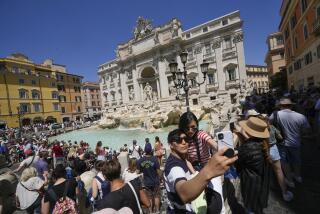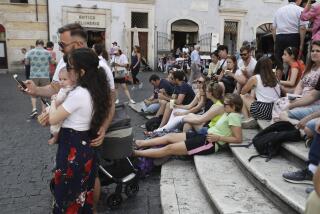Europe is more affordable than you might think
- Share via
PEOPLE ask, “How can I afford to vacation in Europe?” My response: “How can you afford not to vacation in Europe?”
I don’t see how people can bypass this storehouse of cultural and political heritage. How can they do without Europe’s treasures of theater and art? How can they put off the injection of ideas and intellectual excitement that accompany a trip to Europe?
If a trip abroad seems daunting because of the weakness of the U.S. dollar against the euro, then consider these counterbalancing factors:
* It has never been cheaper to fly to Europe. Though the dollar is weak, the level of airfares is weaker. Go to Expedia, Travel- ocity, Orbitz, CheapTickets or a dozen other airfare-booking engines, put in dates and desired destinations, and you’ll find that, in most instances, round-trip airfares are $100 to $200 less than they have been in recent years.
* The European hotel industry is eager for American business and is offering major discounts. The drop-off in normal booking levels has led one European chain after another to create special discounts for American travelers. Go to Priceline .com, Hotels.com, VisitLondon .com, Cheap-Paris.com, Trip Advisor.com, Eurocheapo.com or a dozen other hotel-booking engines, and you’ll find first-class hotels in nearly every city on the continent charging half-off prices.
* European rail passes and city transportation passes are priced in dollars at levels set before the weakening of the dollar -- and those dollar prices have not been revised. The Europeans aren’t crazy. To attract American business, their national rail networks, city bus systems and subway systems are offering advantages limited to overseas visitors that bring the price of transportation down to levels of years ago. The smart traveler goes to the relevant sources of these bargains -- RailEurope.com, TravelBritain.org and many others -- and thus limits the expense of in-city, in-country European transportation before leaving home.
* The increased cost of European meals can be overcome by careful planning and selection. Though the past year’s increase of 30% in the value of the euro has obviously increased food costs by that percentage, the smart tourist can mitigate that development. Need I point out that bookstores are full of guides to moderately priced meals in every major European city?
And by way of self-help, the smart tourist eats cheaper and healthier by scheduling one meal a day as a picnic feast of cold items purchased at grocery stores and food markets -- good sources of tasty European foods.
Moreover, because most European restaurants serve family-size portions, tourists can order one appetizer and one main course for themselves and their travel companion, and then split these dishes between the two of them -- a smart way to reduce European food costs.
* Finally, if you’re still fearful of European prices, you can visit on a cruise of European waters. Port-a-day ships sail the Mediterranean or the North Sea and bring you to a dozen seaside cities in as many days. Travelers can purchase those cruises at reasonable dollar rates and thus obtain overnight accommodations and at least one or two meals a day aboard the ship, without ever having to change dollars into euros.
Pass up Europe this year? I’d rather pass up a dozen other expenditures. For mental balance and a positive outlook, I rely on an annual Europe fix.
More to Read
Sign up for The Wild
We’ll help you find the best places to hike, bike and run, as well as the perfect silent spots for meditation and yoga.
You may occasionally receive promotional content from the Los Angeles Times.






